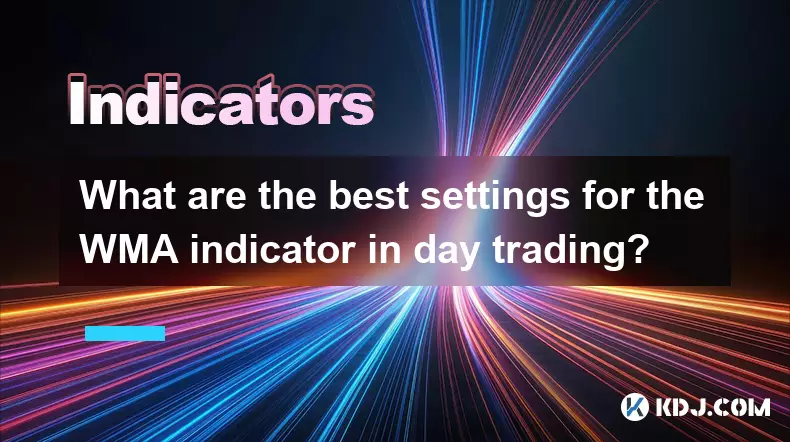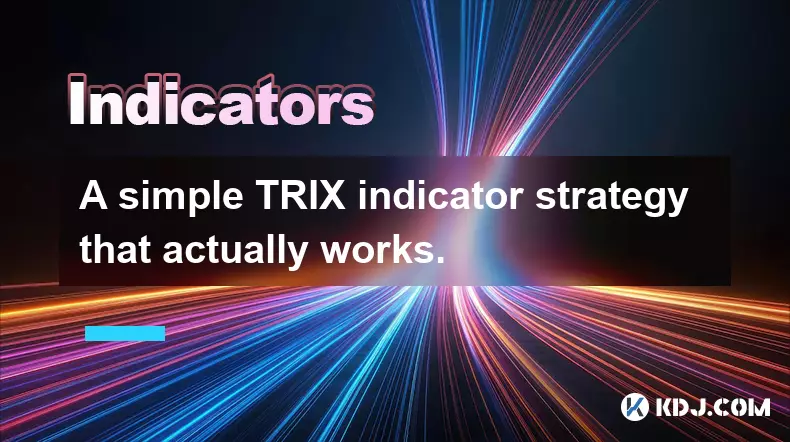-
 bitcoin
bitcoin $101752.865364 USD
-1.09% -
 ethereum
ethereum $3382.985899 USD
-1.38% -
 tether
tether $0.999658 USD
0.04% -
 xrp
xrp $2.272505 USD
-1.51% -
 bnb
bnb $989.089004 USD
0.14% -
 solana
solana $156.962612 USD
-3.08% -
 usd-coin
usd-coin $0.999776 USD
0.01% -
 tron
tron $0.290786 USD
-0.69% -
 dogecoin
dogecoin $0.174594 USD
-2.86% -
 cardano
cardano $0.560085 USD
-3.55% -
 hyperliquid
hyperliquid $40.023704 USD
-5.75% -
 chainlink
chainlink $15.324649 USD
-2.78% -
 bitcoin-cash
bitcoin-cash $493.576540 USD
-3.52% -
 zcash
zcash $571.320038 USD
-12.05% -
 stellar
stellar $0.280066 USD
-4.26%
What are the best settings for the WMA indicator in day trading?
A 9-period WMA is ideal for intraday trading, offering responsiveness to price changes while filtering noise on 1-minute and 5-minute charts.
Nov 06, 2025 at 11:04 am

Optimal WMA Settings for Intraday Strategies
1. A 9-period WMA is widely adopted among day traders due to its responsiveness to short-term price movements. This setting filters out market noise while remaining sensitive enough to capture early trend shifts. Traders using one-minute or five-minute charts often rely on this configuration to identify immediate momentum.
2. For those focusing on slightly longer intraday windows, a 20-period WMA offers a balanced view of the prevailing trend. It smooths erratic fluctuations without lagging excessively behind price action, making it suitable for 15-minute and 30-minute timeframes.
3. Scalpers frequently combine multiple WMA periods—such as 9 and 21—to generate dynamic support and resistance levels. When the shorter WMA crosses above the longer one, it signals potential long entries, especially when aligned with volume spikes.
4. Adjusting WMA length based on market volatility improves signal accuracy. During high-volatility sessions like news releases, reducing the period to 7 can help avoid late entries. In calmer conditions, extending to 25 enhances reliability by minimizing false triggers.
5. Overlaying a 50-period WMA on 5-minute charts helps identify intraday bias. Prices trading above this line suggest bullish sentiment, prompting traders to seek pullback buys. Conversely, sustained price action below indicates bearish control and potential short opportunities.
Enhancing Signal Precision with Volume Confirmation
1. The effectiveness of WMA crossovers increases significantly when validated by rising trading volume. A bullish crossover accompanied by above-average volume in Bitcoin futures suggests strong buyer conviction, reducing the likelihood of a fakeout.
2. In altcoin pairs with low liquidity, WMAs may generate misleading signals. Integrating volume-weighted metrics ensures that moves aren’t driven by isolated trades. For instance, Ethereum/USDT showing a WMA cross with tripled volume confirms institutional participation.
3. Divergence between WMA direction and volume trends warns of weakening momentum. If prices rise above a 13-period WMA but volume declines over three consecutive candles, the uptrend may lack sustainability.
4. Using volume profile alongside WMA helps distinguish between genuine breakouts and stop hunts. A breakout above a key WMA level that coincides with high-volume nodes on the profile adds credibility to the move.
5. Day traders monitoring Binance futures often pair WMA strategies with tick volume analysis. Sudden spikes in trade count during a WMA cross increase confidence in entering leveraged positions.
Adapting WMA to Cryptocurrency Volatility
1. Crypto assets exhibit extreme volatility compared to traditional markets, necessitating tighter WMA settings. A 7-period WMA responds faster than a standard 14-period SMA, crucial during flash rallies in meme coins like DOGE or SHIB.
2. High-frequency trading bots dominate crypto order books, causing rapid price swings. Shorter WMAs allow retail traders to react before algorithms reverse positions. This is particularly effective in perpetual contracts with funding rate imbalances.
3. Overnight gaps are common in 24/7 crypto markets. Applying a 12-period WMA on opening candles helps assess whether price has already invalidated prior day levels, preventing delayed reactions.
4. During exchange outages or network congestion, price data becomes erratic. Temporarily switching to a 30-period WMA reduces whipsaw risk until normal trading resumes across platforms like Coinbase or Kraken.
5. Stablecoins anchored to fiat exhibit lower volatility, permitting longer WMA settings. Traders arbitraging USDC/USDT spreads on decentralized exchanges use 25-period WMAs to detect subtle deviations.
Frequently Asked Questions
Can WMA be used effectively on 1-minute crypto charts?Yes, a 7 to 9-period WMA performs well on 1-minute charts, especially when filtering entries during high-liquidity hours. Combining it with RSI prevents overtrading during sideways consolidation phases.
How does WMA compare to EMA in fast-moving crypto markets?WMA places more weight on recent prices than SMA but less than EMA. In sharp corrections, EMA reacts quicker, but WMA provides fewer false signals during choppy conditions common in altcoin trading.
Should I adjust WMA settings for different cryptocurrencies?Absolutely. Major coins like BTC and ETH respond well to 9–13 period WMAs due to consistent volume. Low-cap tokens with sporadic activity require shorter spans, such as 5–7, to remain relevant.
Is WMA useful for detecting reversals in bear markets?In prolonged downtrends, price reclaiming a declining 20-period WMA can indicate short-term exhaustion. However, confirmation from on-chain metrics like exchange outflows strengthens the reversal hypothesis.
Disclaimer:info@kdj.com
The information provided is not trading advice. kdj.com does not assume any responsibility for any investments made based on the information provided in this article. Cryptocurrencies are highly volatile and it is highly recommended that you invest with caution after thorough research!
If you believe that the content used on this website infringes your copyright, please contact us immediately (info@kdj.com) and we will delete it promptly.
- Ripple (XRP) in 2026: Hold or Fold? A Look at XRP's Future and Emerging DeFi Alternatives
- 2025-11-08 18:35:01
- Zcash ZEC Coin Price Explosion: From Privacy Niche to Center Stage
- 2025-11-08 18:55:01
- Berachain Price Prediction: Navigating the Honeycomb Hype in Crypto
- 2025-11-08 18:55:01
- Arthur Hayes, Gold, and Bitcoin: A Modern Monetary Trinity?
- 2025-11-08 19:15:01
- Shiba Inu's Next Move: Navigating a Shifting Market
- 2025-11-08 19:20:01
- Pakistan's Crypto Crossroads: Balancing Opportunity with Asset-Backed Realities
- 2025-11-08 19:20:01
Related knowledge

How do professional traders use the TRIX indicator?
Nov 06,2025 at 04:40pm
Understanding the TRIX Indicator in Crypto TradingThe TRIX (Triple Exponential Average) indicator is a momentum oscillator used by professional trader...

Can I use the TRIX indicator on my mobile trading app?
Nov 07,2025 at 07:40pm
The TRIX indicator, a momentum oscillator designed to filter out short-term fluctuations and highlight long-term trends, has become increasingly popul...

How to code a simple TRIX indicator script in Pine Script?
Nov 07,2025 at 06:20am
How to Code a Simple TRIX Indicator in Pine Script The TRIX (Triple Exponential Moving Average) indicator is widely used in cryptocurrency trading to ...

A simple TRIX indicator strategy that actually works.
Nov 08,2025 at 05:39pm
Understanding the TRIX Indicator in Crypto Trading1. The TRIX (Triple Exponential Average) indicator is a momentum oscillator designed to filter out s...

How to trade TRIX indicator signals on the 1-hour chart?
Nov 07,2025 at 05:39am
Bitcoin's Role in Decentralized Finance1. Bitcoin remains the cornerstone of decentralized finance, serving as a benchmark for value and security acro...

Can the TRIX indicator be used for long-term investing?
Nov 06,2025 at 02:19pm
Understanding the TRIX Indicator in Cryptocurrency Markets1. The TRIX (Triple Exponential Average) indicator is a momentum oscillator designed to filt...

How do professional traders use the TRIX indicator?
Nov 06,2025 at 04:40pm
Understanding the TRIX Indicator in Crypto TradingThe TRIX (Triple Exponential Average) indicator is a momentum oscillator used by professional trader...

Can I use the TRIX indicator on my mobile trading app?
Nov 07,2025 at 07:40pm
The TRIX indicator, a momentum oscillator designed to filter out short-term fluctuations and highlight long-term trends, has become increasingly popul...

How to code a simple TRIX indicator script in Pine Script?
Nov 07,2025 at 06:20am
How to Code a Simple TRIX Indicator in Pine Script The TRIX (Triple Exponential Moving Average) indicator is widely used in cryptocurrency trading to ...

A simple TRIX indicator strategy that actually works.
Nov 08,2025 at 05:39pm
Understanding the TRIX Indicator in Crypto Trading1. The TRIX (Triple Exponential Average) indicator is a momentum oscillator designed to filter out s...

How to trade TRIX indicator signals on the 1-hour chart?
Nov 07,2025 at 05:39am
Bitcoin's Role in Decentralized Finance1. Bitcoin remains the cornerstone of decentralized finance, serving as a benchmark for value and security acro...

Can the TRIX indicator be used for long-term investing?
Nov 06,2025 at 02:19pm
Understanding the TRIX Indicator in Cryptocurrency Markets1. The TRIX (Triple Exponential Average) indicator is a momentum oscillator designed to filt...
See all articles





















![The Graph Price Prediction [GRT Crypto Price News Today] The Graph Price Prediction [GRT Crypto Price News Today]](/uploads/2025/11/07/cryptocurrencies-news/videos/690d4df44fe69_image_500_375.webp)



















































